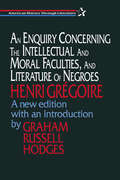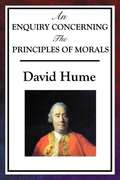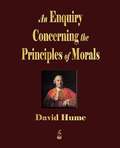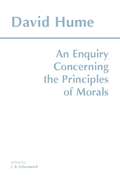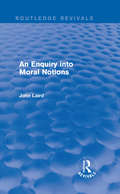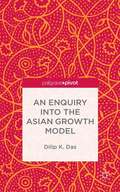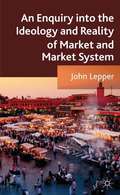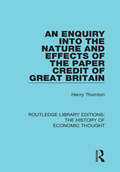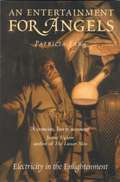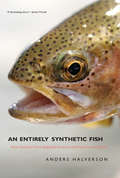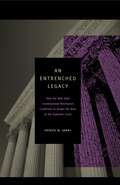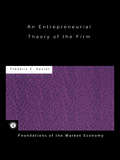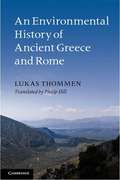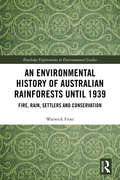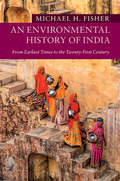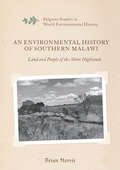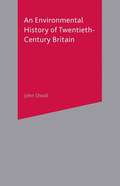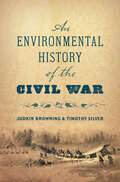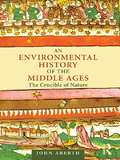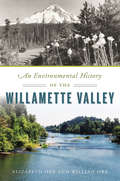- Table View
- List View
An Enquiry Concerning the Intellectual and Moral Faculties and Literature of Negroes
by Graham Hodges Henri GregoireAmongst other things, this book is a devastating critique of Thomas Jefferson's Notes on the State of Virginia, in which he mused about black inferiority. Its publication in 1810, after Jefferson's opposition to its appearance, was a major event for African Americans.
An Enquiry Concerning the Principles of Morals
by David HumeDavid Hume's An Enquiry Concerning the Principles of Morals argues that morals are not based in rational thought, but rather are sentimental endeavors. This text highlights how approval and disapproval can be used to make moral judgments, and how this might elevate certain aspects of society. Hume's book delves into the human psyche and, therefore, aids our understanding of society and life as a whole.
An Enquiry Concerning the Principles of Morals
by David HumeThe subject of the Enquiry is the contributions that moral sense and reason make in our moral judgments. Hume claims that moral sense makes the ultimate distinction between vice and virtue, though both moral sense and reason play a role in our formation of moral judgments. <P> <P> Reason is important when we have to make a judgment about what is useful, for reason alone can determine how and why something is useful to us or to others. Hume briefly addresses what moral judges usually include in their lists of virtues, what they leave out, and how they make these lists. He then returns to the classification of virtues he proposed first in the Treatise. <P> <P> Hume first distinguishes between artificial and natural virtues. Artificial virtues depend on social structures and include justice and fidelity to promises; allegiance; chastity and modesty; and duties of sovereign states to keep treaties, to respect boundaries, to protect ambassadors, and to otherwise subject themselves to the law of nations. Hume defines each of these virtues and explains how each manifests itself in the world. He notes that artificial virtues vary from society to society. <P> <P> Natural virtues, on the other hand, originate in nature and are more universal. They include compassion, generosity, gratitude, friendship, fidelity, charity, beneficence, clemency, equity, prudence, temperance, frugality, industry, courage, ambition, pride, modesty, self-assertiveness, good sense, wit and humor, perseverance, patience, parental devotion, good nature, cleanliness, articulateness, sensitivity to poetry, decorum, and an elusive quality that makes a person lovely or valuable. Some of these virtues are voluntary, such as pride, while others are involuntary, such as good sense. <P> <P> As in the Treatise, Hume explains that reason does not cause our actions. Instead, moral sentiments, or passions, motivate us to act. In the Enquiry, however, Hume goes further to state that our actions are caused by a combination of utility and sentiment. In other words, we must care about the outcome if we are to care about the means by which it is achieved. Several sections of the Enquiry are devoted to utility, the first and most important of the four kinds of virtue, which Hume calls “virtuous because useful.” He also addresses benevolence and its role in the moral process. Specifically, Hume says that benevolent acts are virtuous because they are useful to many others.
An Enquiry Concerning the Principles of Morals
by David Hume J. B. SchneewindA splendid edition. Schneewind's illuminating introduction succinctly situates the Enquiry in its historical context, clarifying its relationship to Calvinism, to Newtonian science, and to earlier moral philosophers, and providing a persuasive account of Hume's ethical naturalism. --Martha C. Nussbaum, Brown University
An Enquiry into Moral Notions (Routledge Revivals)
by John LairdFirst published in 1935, this book compares and examines what John Laird termed the ‘three most important notions in ethical science’: the concepts of virtue, duty and well-being. Laird poses the question of whether any one of these three concepts is capable of being the foundation of ethics and of supporting the other two. This is an interesting reissue, which will be of particular value to students researching the philosophy of ethics and morality.
An Enquiry into the Asian Growth Model
by Dilip K. DasDuring the post-World War-II period, several Asian economies turned in stellar performances. This book addresses the all-important query regarding the ebullient growth performance of a group of dynamic Asian economies. Its principal focus is the so-called Asian growth model, which enabled them to achieve what became known as the 'miraculous' growth
An Enquiry into the Ideology and Reality of Market and Market System
by John LepperWhy do markets exist? How are they maintained? What are market systems and how are they formed? This book addresses these fundamental questions and challenges the traditional view that markets and market systems are 'natural', asserting instead that they are ideologically coloured and of dubious scientific value.
An Enquiry into the Nature and Effects of the Paper Credit of Great Britain (Routledge Library Editions: The History of Economic Thought #12)
by Henry ThorntonThis book, first edited with an introduction by F. A. v. Hayek in 1939, explores some of the popular errors which related to the suspension of the cash payments of the Bank of England, and to the influence of our paper currency on the price of provisions. The introduction provides an interesting overview of the life, thoughts, and achievements of Henry Thornton. An Enquiry into the Nature and Effects of the Paper Credit of Great Britain will be of interest to students of the history of economic thought.
An Entertainment for Angels: Electricity in the Enlightenment
by Patricia FaraCharacterizing electricity as "the greatest scientific invention of the Enlightenment," Fara (history of science, U. of Cambridge, UK) reconstructs the history of the discovery of electricity that pre- existed Benjamin Franklin's oft-cited kite. It is a history in which the instruments largely preceded the theory and "there was no clear path of development." Nevertheless, the development of those instruments, especially air pumps and Leyden jars, was absolutely necessary for later discoveries about electricity. Annotation ©2004 Book News, Inc., Portland, OR (booknews.com)
An Entirely Synthetic Fish
by Anders HalversonAnders Halverson provides an exhaustively researched and grippingly rendered account of the rainbow trout and why it has become the most commonly stocked and controversial freshwater fish in the United States. Discovered in the remote waters of northern California, rainbow trout have been artificially propagated and distributed for more than 130 years by government officials eager to present Americans with an opportunity to get back to nature by going fishing. Proudly dubbed "an entirely synthetic fish" by fisheries managers, the rainbow trout has been introduced into every state and province in the United States and Canada and to every continent except Antarctica, often with devastating effects on the native fauna. Halverson examines the paradoxes and reveals a range of characters, from nineteenth-century boosters who believed rainbows could be the saviors of democracy to twenty-first-century biologists who now seek to eradicate them from waters around the globe. Ultimately, the story of the rainbow trout is the story of our relationship with the natural world--how it has changed and how it startlingly has not.
An Entrenched Legacy: How the New Deal Constitutional Revolution Continues to Shape the Role of the Supreme Court
by Patrick M. GarryAn Entrenched Legacy takes a fresh look at the role of the Supreme Court in our modern constitutional system. Although criticisms of judicial power today often attribute its rise to the activism of justices seeking to advance particular political ideologies, Patrick Garry argues instead that the Supreme Court’s power has grown mainly because of certain constitutional decisions during the New Deal era that initially seemed to portend a lessening of the Court’s power. When the Court retreated from enforcing separation of powers and federalism as the twin structural protections for individual liberty in the face of FDR’s New Deal agenda, it was inevitably drawn into an alternative approach, substantive due process, as a means for protecting individual rights. This has led to many controversial judicial rulings, particularly regarding the recognition and enforcement of privacy rights. It has also led to the mistaken belief that the judiciary serves as the only protection of liberty and that an inherent conflict exists between individual liberty and majoritarian rule. Moreover, because the Court has assumed sole responsibility for preserving liberty, the whole area of individual rights has become highly centralized. As Garry argues, individual rights have been placed exclusively under judicial jurisdiction not because of anything the Constitution commands, but because of the constitutional compromise of the New Deal.During the Rehnquist era, the Court tried to reinvigorate the constitutional doctrine of federalism by strengthening certain powers of the states. But, according to Garry, this effort only went halfway toward a true revival of federalism, since the Court continued to rely on judicially enforced individual rights for the protection of liberty. A more comprehensive reform would require a return to the earlier reliance on both federalism and separation of powers as structural devices for protecting liberty. Such reform, as Garry notes, would also help revitalize the role of legislatures in our democratic system.
An Entrepreneur's New Product Development Journey
by Elie OfekThis case tracks the new product development process undertaken by Gauri Nanda, the founder and CEO of Nanda Home, as she ventures to innovate beyond her initial product launches. Having achieved commercial success with her first product Clocky, a roll away alarm clock that owners interacted with in a way they found functionally and emotionally appealing, and after two extensions of the line, Nanda thought it was time to design, develop and market another item that would solve an everyday problem with lifelike charm. She wanted to create a clock that would appeal to children and their parents by facilitating kids' going to sleep and waking up routines. However, there were several factors Nanda had to grapple with before she could commit to final manufacturing design and development. Did she conduct sufficient market research to verify the desire for the 'Clockiddie' concept and the features planned? Were her assumptions about parents and kids valid to suggest the product would be in high demand once launched? Could she keep a premium price point in a consumer market that was trending downward in willingness to pay? Should she cut back on differentiating features to reduce costs and price? Or could the product be engineered under current specifications to an acceptable cost of goods and retail price point? These decisions had to be made soon so that the product could be launched to meet the back to school buying period.
An Entrepreneurial Theory of the Firm (Routledge Foundations Of The Market Economy Ser.)
by Frederic SautetThis original, provocative work makes a thorough and comprehensive enquiry into the relationship that exists between firms and markets, with separate, in-depth examinations of both the existence and inner organisation of the firm. Sautet develops an accomplished and convincing theory that encompasses a wealth of existing literature and leads it in
An Environmental History of Ancient Greece and Rome
by Lukas Thommen Philip HillIn ancient Greece and Rome an ambiguous relationship developed between man and nature, and this decisively determined the manner in which they treated the environment. On the one hand, nature was conceived as a space characterized and inhabited by divine powers, which deserved appropriate respect. On the other, a rationalist view emerged, according to which humans were to subdue nature using their technologies and to dispose of its resources. This book systematically describes the ways in which the Greeks and Romans intervened in the environment and thus traces the history of the tension between the exploitation of resources and the protection of nature, from early Greece to the period of late antiquity. At the same time it analyses the comprehensive opening up of the Mediterranean and the northern frontier regions, both for settlement and for economic activity. The book's level and approach make it highly accessible to students and non-specialists.
An Environmental History of Australian Rainforests until 1939: Fire, Rain, Settlers and Conservation (Routledge Explorations in Environmental Studies)
by Warwick FrostThis book provides a comprehensive environmental history of how Australia’s rainforests developed, the influence of Aborigines and pioneers, farmers and loggers, and of efforts to protect rainforests, to help us better understand current issues and debates surrounding their conservation and use. While interest in rainforests and the movement for their conservation are often mistakenly portrayed as features of the last few decades, the debate over human usage of rainforests stretches well back into the nineteenth century. In the modern world, rainforests are generally considered the most attractive of the ecosystems, being seen as lush, vibrant, immense, mysterious, spiritual and romantic. Rainforests hold a special place; both providing a direct link to Gondwanaland and the dinosaurs and today being the home of endangered species and highly rich in biodiversity. They are also a critical part of Australia’s heritage. Indeed, large areas of Australian rainforests are now covered by World Heritage Listing. However, they also represent a dissonant heritage. What exactly constitutes rainforest, how it should be managed and used, and how much should be protected are all issues which remain hotly contested. Debates around rainforests are particularly dominated by the contradiction of competing views and uses – seeing rainforests either as untapped resources for agriculture and forestry versus valuing and preserving them as attractive and sublime natural wonders. Australia fits into this global story as a prime example but is also of interest for its aspects that are exceptional, including the intensity of clearing at certain periods and for its place in the early development of national parks. This book will be of great interest to students and scholars of Environmental History, Australian History and Comparative History.
An Environmental History of India: From Earliest Times to the Twenty-First Century (New Approaches to Asian History)
by Michael H. FisherIndia, Pakistan, and Bangladesh contain one-fifth of humanity, many biodiversity hotspots, and are among the nations most subject to climatic stresses. By surveying their environmental history, we can gain major insights into the causes and implications of the Indian subcontinent's current conditions. This accessible new survey begins roughly one hundred million years ago, when continental drift moved India from the South Pole and across the Indian Ocean, forming the Himalayan Mountains and creating monsoons. Coverage continues to the twenty-first century, taking readers beyond independence from colonial rule. The new nations of India, Pakistan, and Bangladesh have produced rising populations and stretched natural resources, even as they became increasingly engaged with climate change. To understand the region's current and future pressing issues, Michael H. Fisher argues that we must engage with the long and complex history of interactions among its people, land, climate, flora, and fauna.
An Environmental History of Latin America
by Shawn William MillerThis book narrates the mutually mortal historical contest between humans and nature in Latin America. Covering a period that begins with Amerindian civilizations and concludes in the region's present urban agglomerations, the work offers an original synthesis of the current scholarship on Latin America's environmental history and argues that tropical nature played a central role in shaping the region's historical development. Seeing Latin America's environmental past from the perspective of many centuries illustrates that human civilizations, ancient and modern, have been simultaneously more powerful and more vulnerable than previously thought.
An Environmental History of Medieval Europe
by Richard C. HoffmannAs the very first book of its kind, An Environmental History of Medieval Europe provides a highly original survey of medieval relations with the natural world. Engaging with the interdisciplinary enterprise of environmental history, it examines the way in which natural forces affected people, how people changed their surroundings, and how they thought about the world around them. Exploring key themes in medieval history - including the decline of Rome, religious doctrine, and the long fourteenth century - Hoffmann draws fresh conclusions about enduring questions regarding agrarian economies, tenurial rights, technology and urbanization. Revealing the significance of the natural world on events previously thought of as purely human, the book explores issues including the treatment of animals, sustainability, epidemic disease and climate change, and by introducing medieval history in the context of social ecology, brings the natural world into historiography as an agent and object of history itself.
An Environmental History of Russia
by Paul Josephson Nicolai Dronin Aleh Cherp Ruben Mnatsakanian Dmitry Efremenko Vladislav LarinThe former Soviet empire spanned eleven time zones and contained half the world's forests; vast deposits of oil, gas and coal; various ores; major rivers such as the Volga, Don and Angara; and extensive biodiversity. These resources and animals, as well as the people who lived in the former Soviet Union – Slavs, Armenians, Georgians, Azeris, Kazakhs and Tajiks, indigenous Nenets and Chukchi – were threatened by environmental degradation and extensive pollution. This environmental history of the former Soviet Union explores the impact that state economic development programs had on the environment. The authors consider the impact of Bolshevik ideology on the establishment of an extensive system of nature preserves, the effect of Stalinist practices of industrialization and collectivization on nature, and the rise of public involvement under Khrushchev and Brezhnev, and changes to policies and practices with the rise of Gorbachev and the break-up of the USSR.
An Environmental History of Southern Malawi: Land and People of the Shire Highlands (Palgrave Studies in World Environmental History)
by Brian MorrisThis book is a pioneering and comprehensive study of the environmental history of Southern Malawi. With over fifty years of experience, anthropologist and social ecologist Brian Morris draws on a wide range of data – literary, ethnographic and archival – in this interdisciplinary volume. Specifically focussing on the complex and dialectical relationship between the people of Southern Malawi, both Africans and Europeans, and the Shire Highlands landscape, this study spans the nineteenth century until the end of the colonial period. It includes detailed accounts of the early history of the peoples of Northern Zambezia; the development of the plantation economy and history of the tea estates in the Thyolo and Mulanje districts; the Chilembwe rebellion of 1915; and the complex tensions between colonial interests in conserving natural resources and the concerns of the Africans of the Shire Highlands in maintaining their livelihoods.A landmark work, Morris’s study constitutes a major contribution to the environmental history of Southern Africa. It will appeal not only to scholars, but to students in anthropology, economics, history and the environmental sciences, as well as to anyone interested in learning more about the history of Malawi, and ecological issues relating to southern Africa.
An Environmental History of Twentieth-Century Britain
by John SheailEnvironmental history - the history of the relationship between people and the natural world - is a dynamic and increasingly important field. In An Environmental History of Twentieth-Century Britain, John Sheail breaks new ground in illustrating how some of the most pressing concerns came to be recognised, and a response made. Much use is made of archival sources in tracing a number of key issues, including: * management of change by central and local government * the manner in which natural processes were incorporated in projects to protect personal and public health, and ultimately environmental health * new beginnings in forestry * the emergence of a third force alongside farming and forestry in the countryside * management of a transport revolution, and mitigation of environmental hazards Such instances of policy-making are reviewed within the wider context of a growing awareness, both on the part of government and business, of the role of environmental issues in the creation of wealth and social well-being for us all. An Environmental History of Twentieth-Century Britain is essential reading for all those concerned with these issues.
An Environmental History of the Civil War (Civil War America)
by Judkin Browning Timothy SilverThis sweeping new history recognizes that the Civil War was not just a military conflict but also a moment of profound transformation in Americans' relationship to the natural world. To be sure, environmental factors such as topography and weather powerfully shaped the outcomes of battles and campaigns, and the war could not have been fought without the horses, cattle, and other animals that were essential to both armies. But here Judkin Browning and Timothy Silver weave a far richer story, combining military and environmental history to forge a comprehensive new narrative of the war's significance and impact. As they reveal, the conflict created a new disease environment by fostering the spread of microbes among vulnerable soldiers, civilians, and animals; led to large-scale modifications of the landscape across several states; sparked new thinking about the human relationship to the natural world; and demanded a reckoning with disability and death on an ecological scale. And as the guns fell silent, the change continued; Browning and Silver show how the war influenced the future of weather forecasting, veterinary medicine, the birth of the conservation movement, and the establishment of the first national parks. In considering human efforts to find military and political advantage by reshaping the natural world, Browning and Silver show not only that the environment influenced the Civil War's outcome but also that the war was a watershed event in the history of the environment itself.
An Environmental History of the Middle Ages: The Crucible of Nature
by John AberthThe Middle Ages was a critical and formative time for Western approaches to our natural surroundings. An Environmental History of the Middle Ages is a unique and unprecedented cultural survey of attitudes towards the environment during this period. Humankind’s relationship with the environment shifted gradually over time from a predominantly adversarial approach to something more overtly collaborative, until a series of ecological crises in the late Middle Ages. With the advent of shattering events such as the Great Famine and the Black Death, considered efflorescences of the climate downturn known as the Little Ice Age that is comparable to our present global warming predicament, medieval people began to think of and relate to their natural environment in new and more nuanced ways. They now were made to be acutely aware of the consequences of human impacts upon the environment, anticipating the cyclical, "new ecology" approach of the modern world. Exploring the entire medieval period from 500 to 1500, and ranging across the whole of Europe, from England and Spain to the Baltic and Eastern Europe, John Aberth focuses his study on three key areas: the natural elements of air, water, and earth; the forest; and wild and domestic animals. Through this multi-faceted lens, An Environmental History of the Middle Ages sheds fascinating new light on the medieval environmental mindset. It will be essential reading for students, scholars and all those interested in the Middle Ages
An Environmental History of the Willamette Valley (Natural History)
by Elizabeth Orr William OrrWestern Oregon's Willamette Basin, once a vast wilderness, became a thriving community almost overnight. When Oregon territory was opened for homesteading in the early 1800s, most of the intrepid pioneers settled in the valley, spurring rapid changes in the landscape. Heralded as fertile with a mild climate and an abundance of natural resources, the valley enticed farmers, miners and loggers, who were quickly followed by the construction of rail lines and roads. Dams were built to harness the once free-flowing Willamette River and provide power to the growing population. As cities rose, people like Portland architect Edward Bennett and conservationist governor Tom McCall worked to contain urban sprawl. Authors Elizabeth and William Orr bring to life the changes that sculpted Oregon's beloved Willamette Valley.
An Environmental History of the World: Humankind's Changing Role in the Community of Life
by J. Donal Hughes J. Donald HughesThis second edition of An Environmental History of the World continues to present a concise history, from ancient to modern times, of the interactions between human societies and the natural environment, including the other forms of life that inhabit our planet. Throughout their evolutionary history, humans have affected the natural environment, sometimes with a promise of sustainable balance, but also in a destructive manner. This book investigates the ways in which environmental changes, often the result of human actions, have caused historical trends in human societies. This process has happened in every historical period and in every part of the inhabited earth. The book is organized into ten chapters. The main chapters follow a chronological path through the history of mankind, in relationship to ecosystems around the world. The first explains what environmental history is, and argues for its importance in understanding the present state of the world's ecological problems. Chapters two through eight form the core of the historical analysis, each concentrating on a major period of human history (pre-civilized, early civilizations, classical, medieval, early modern, early and later twentieth century, and contemporary) that has been characterized by large-scale changes in the relationship between human societies and the biosphere, and each gives several case studies that illustrate significant patterns occurring at that time. The chapters covering contemporary times discuss the physical impacts of the huge growth in population and technology, and the human responses to these problems. Our moral obligations to nature and how we can achieve a sustainable balance between technology and the environment are also considered. This revised second edition takes account of new research and the course of history containing new sections on global warming, the response of New Orleans to the hurricanes Katrina and Rita, and the experience of the Dutch people in protecting their low-lying lands against the encroachments of rivers, lakes, and the North Sea. New material is also offered on the Pacific Islands, including the famous case of Easter Island. This is an original work that reaches further than other environmental histories. Rather than looking at humans and the environment as separate entities, this book places humans within the community of life. The relationship between environmental thought and actions, and their evolution, is discussed throughout. Little environmental or historical knowledge is assumed from the reader in this introduction to environmental history. We cannot reach a useful understanding of modern environmental problems without the aid of perspective provided by environmental history, with its illustrations of the ways in which past decisions helped or hindered the interaction between nature and culture. This book will be influential and timely to all interested in or researching the world in which we live.
